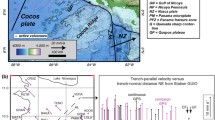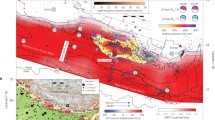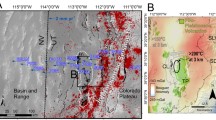Abstract
Flank instability and collapse are observed at many volcanoes. Among these, Mt. Etna is characterized by the spreading of its eastern and southern flanks. The eastern spreading area is bordered to the north by the E–W-trending Pernicana Fault System (PFS). During the 2002–2003 Etna eruption, ground fracturing along the PFS migrated eastward from the NE Rift, to as far as the 18 km distant coastline. The deformation consisted of dextral en-echelon segments, with sinistral and normal kinematics. Both of these components of displacement were one order of magnitude larger (~1 m) in the western, previously known, portion of the PFS with respect to the newly surveyed (~9 km long) eastern section (~0.1 m). This eastern section is located along a pre-existing, but previously unknown, fault, where displaced man-made structures give overall slip rates (1–1.9 cm/year), only slightly lower than those calculated for the western portion (1.4–2.3 cm/year). After an initial rapid motion during the first days of the 2002–2003 eruption, movement of the western portion of the PFS decreased dramatically, while parts of the eastern portion continued to move. These data suggest a model of spreading of the eastern flank of Etna along the PFS, characterized by eruptions along the NE Rift, instantaneous, short-lived, meter-scale displacements along the western PFS and more long-lived centimeter-scale displacements along the eastern PFS. The surface deformation then migrated southwards, reactivating, one after the other, the NNW–SSE-trending Timpe and Trecastagni faults, with displacements of ~0.1 and ~0.04 m, respectively. These structures, along with the PFS, mark the boundaries of two adjacent blocks, moving at different times and rates. The new extent of the PFS and previous activity over its full length indicate that the sliding eastern flank extends well below the Ionian Sea. The clustering of seismic activity above 4 km b.s.l. during the eruption suggests a deep décollement for the moving mass. The collected data thus suggests a significant movement (volume >1,100 km3) of the eastern flank of Etna, both on-shore and off-shore.












Similar content being viewed by others
References
Acocella V, Neri M (2003) What makes flank eruptions? The 2001 Mount Etna eruption and its possible triggering mechanisms. Bull Volcanol 65:517–529 10.1007/s00445-003-0280-3
Ando M (1979) The Hawaii earthquake of November 29, 1975: low dip angle faulting due to forceful injection of magma. J Geophys Res 84:7616–7626
Azzaro R, Lo Giudice E, Rasà R (1988) Il terremoto di Piano Pernicana (Etna Nord) del 28/10/1988. Campo macrosismico e quadro deformativo fragile associato all’evento. Boll GNV 4:22–40
Azzaro R, Branca S, Giammanco S, Gurrieri S, Rasà R, Valenza M (1998) New evidence for the form and extent of the Pernicana Fault System (Mt. Etna) from structural and soil-gas surveying. J Volcanol Geotherm Res 84:143–152
Behncke B, Neri M (2003) The July-August 2001 eruption of Mount Etna (Sicily). Bull Volcanol 65:461–476 10.1007/s00445-003-0274-1
Billi A, Acocella V, Funiciello R, Giordano G, Lanzafame G, Neri M (2003) Mechanisms for ground-surface fracturing and incipient slope failure associated to the July-August 2001 eruption of Mt. Etna, Italy: analysis of ephemeral field data. J Volcanol Geotherm Res 122:281–294 10.1016/S0377-0273(02)00507-3
Borgia A, Ferrari L, Pasquarè G (1992) Importance of gravitational spreading in the tectonic and volcanic evolution of Mt. Etna. Nature 357:231–235
Borgia A, Delaney PT, Denlinger RP (2000a) Spreading volcanoes. Ann Rev Earth Planet Sci 28:539–570
Borgia A, Lanari R, Sansosti E, Tesauro M, Berardino P, Fornaro G, Neri M, Murray JB (2000b) Actively growing anticlines beneath Catania from the distal motion of Mount Etna’s decollement measured by SAR interferometry and GPS. Geophys Res Lett 27:3409–3412
Bousquet JC, Lanzafame G (2001) Nouvelle interprétation des fractures des éruptions latérales de l’Etna: conséquences pour son cadre tectonique. Bull Soc Géol Fr 172:455–467
Calvari S, Pinkerton H (2002) Instabilities in the summit region of Mount Etna during the 1999 eruption. Bull Volcanol 63:526–535
Calvari S, INGV-CT scientific staff (2002) Update on the eruptive activity at Mt. Etna: Multidisciplinary evidence of magma refilling (abs). Eos Trans. AGU 83(47) Fall Meet, Suppl F1483
Delaney PT, Denlinger RP, Lisowski M, Miklius A, Okubo PG, Okamura AT, Sako MK (1998) Volcanic spreading at Kilauea, 1976–1996. J Geophys Res 103:18003–18023
Delaney PT, Denlinger RP (1999) Stabilization of volcanic flanks by dike intrusion: an example from Kilauea. Bull Volcanol 61:356–362
Dvorak JJ, Okamura AT, English TT, Koyanagi RY, Nakata JS, Sako MK, Tanigawa WT, Yamashita WT (1986) Mechanical response of the south flank of Kilauea volcano, Hawaii, to intrusive events along the rift systems. Tectonophysics 124:193–209
Ferrari L, Garduño VH, Neri M (1991) I dicchi della valle del Bove, Etna: un metodo per stimare le dilatazioni di un apparato vulcanico. Mem Soc Geol Ital 47:495–508
Froger JL, Merle O, Briole P (2001) Active spreading and regional extension at Mount Etna imaged by SAR interferometry. Earth Planet Sci Lett 187:245–258
Garduño VH, Neri M, Pasquarè G, Borgia A, Tibaldi A (1997) Geology of the NE Rift of Mount Etna, Sicily (Italy). Acta Vulcanol 9:91–100
INGV (2002) List of Italian earthquakes (16–30 Sep, 2002). http://www.ingv.it/~roma/reti/rms/bollettino/set0202/lista.htm
Kieffer G (1985) Évolution structurale et dynamique d’un grand volcan polygénique: stade d’édification et activité actuelle de l’Etna. PhD Thesis, Univ Clermont-Ferrand II, pp 1–497
Lanzafame G, Neri M, Acocella V, Billi A, Funiciello R, Giordano G (2003) Structural features of the July-August 2001 Mount Etna eruption: evidence for a complex magmatic system. J Geol Soc Lond 160:531–544
Lo Giudice E, Rasà R (1992) Very shallow earthquakes and brittle deformation in active volcanic areas: the etnean region as an example. Tectonophysics 202:257–268
McGuire WJ, Pullen AD (1989) Location and orientation of eruptive fissures and feeder-dykes at Mount Etna: influence of gravitational and regional stress regimes. J Volcanol Geotherm Res 38:325–244
Neri M, Garduño VH, Pasquarè G, Rasà R (1991) Studio strutturale e modello cinematico della Valle del Bove e del settore nord-orientale etneo. Acta Vulcanol 1:17–24
Neri M, Rossi M (2002) Geometria e volume dell’apparato vulcanico etneo: il contributo offerto dall’uso di mappe digitali. Quad Geofis 20:9–15 http://www.ingv.it/~roma/cultura/biblioteca/biblioframe.html
Obrizzo F, Pingue F, Troise C, De Natale G (2001) Coseismic displacements and creeping along the Pernicana fault (Etna, Italy) in the last 17 years: a detailed study of a tectonic structure on a volcano. J Volcanol Geotherm Res 109:109–131
Parfitt EA, Peacock DCP (2001) Faulting in the south flank of Kilauea volcano, Hawaii. J Volcanol Geotherm Res 106:265–284
Patanè D (2002) Aggiornamento delle attività di monitoraggio sismico all’Etna. http://www.ct.ingv.it/report/Rapporto_eruzione20021030.pdf
Patanè D, De Gori P, Chiarabba C, Bonaccorso A (2003) Magma ascent and the pressurization of Mount Etna’s volcanic system. Science 299:2061–2063 10.1126/science.1080653
Pompilio M, Miraglia L, Corsaro RA (2002) I prodotti dell’eruzione di Ottobre 2002. Dati preliminari. http://www.ct.ingv.it/Etna2002/Geo&Vulca/descprodotti30–10.htm
Pompilio M, Rutherford MJ (2002) Pre-eruption conditions and magma dynamics of recent amphibole-bearing Etna basalt (abs.) Eos Trans AGU 83(47) Fall Meet Suppl, F1419
Rust D, Neri M (1996) The boundaries of large-scale collapse on the flanks of Mount Etna, Sicily. In: McGuire WJ, Jones AP, Neuberg J (eds) Volcano instability on the Earth and other planets. Geol Soc Lond Spec Pub 110:193–208
Swanson DA, Duffield WA, Fiske RS (1976) Displacement of the south flank of Kilauea volcano: the result of forceful intrusion of magma into the rift zones. US Geol Surv Prof Pap 963, 39 pp
Tanguy JC, Kieffer G (1993) Les éruptions de l’Etna et leurs mécanismes. Mém Soc Géol Fr 163:239–252
Tibaldi A, Groppelli G (2002) Volcano-tectonic activity along structures of the unstable NE flank of Mt. Etna (Italy) and their possible origin. J Volcanol Geotherm Res 115:277–302
Van Wyk de Vries B, Francis PW (1997) Catastrophic collapse at stratovolcanoes induced by slow volcano spreading. Nature 387:387–390
Van Wyk de Vries B, Self S, Francis PW, Keszthelyi L (2001) A gravitational spreading origin for the Socompa debris avalanche. J Volcanol Geotherm Res 105:225–247
Voight B, Glicken H, Janda RJ, Douglas PM (1981) Catastrophic rockslide avalanche of May 18. In: Lipman PW, Mullineaux DR (eds) The 1980 eruptions of Mount St. Helens, Washington. Geol Surv Prof Pap 1250:347–377
Acknowledgements
The authors wish to thank R. Funiciello for his support during the research. This work was partly financed with GNDT funds co-ordinated by C. Faccenna at Roma Tre University. Benjamin van Wyk de Vries and Andrea Borgia are acknowledged for their constructive reviews which significantly improved the quality of the paper, along with the helpful additional comments by Associate Editor Raffaello Cioni.
Author information
Authors and Affiliations
Corresponding author
Additional information
Editorial responsibility: R. Cioni
Rights and permissions
About this article
Cite this article
Neri, M., Acocella, V. & Behncke, B. The role of the Pernicana Fault System in the spreading of Mt. Etna (Italy) during the 2002–2003 eruption. Bull Volcanol 66, 417–430 (2004). https://doi.org/10.1007/s00445-003-0322-x
Received:
Accepted:
Published:
Issue Date:
DOI: https://doi.org/10.1007/s00445-003-0322-x




